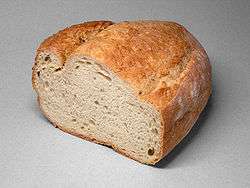Bakery

A bakery (aka, baker's shop or bake shop) is an establishment that produces and sells flour-based food baked in an oven such as bread, cookies, cakes, pastries, and pies.[1] Some retail bakeries are also cafés, serving coffee and tea to customers who wish to consume the baked goods on the premises.
History

Baked goods have been around for thousands of years. The art of baking was developed early during the Roman Empire. It was a highly famous art as Roman citizens loved baked goods and demanded for them frequently for important occasions such as feasts and weddings etc. Due to the fame and desire that the art of baking received, around 300 BC, baking was introduced as an occupation and respectable profession for Romans. The bakers began to prepare bread at home in an oven, using mills to grind grain into the flour for their breads. The oncoming demand for baked goods vigorously continued and the first bakers' guild was established in 168 BC in Rome. This drastic appeal for baked goods promoted baking all throughout Europe and expanded into the eastern parts of Asia. Bakers started baking breads and goods at home and selling them out on the streets.
This trend became common and soon, baked products were getting sold in streets of Rome, Germany, London and many more. This resulted in a system of delivering the goods to households, as the demand for baked breads and goods significantly increased. This provoked the bakers to establish a place where people could purchase baked goods for themselves. Therefore, in Paris, the first open-air bakery of baked goods was developed and since then, bakeries became a common place to purchase delicious goods and get together around the world. By the colonial era, bakeries were commonly viewed as places to gather and socialize.[2] World War II directly affected bread industries in the UK. Baking schools closed during this time so when the war did eventually end there was an absence of skilled bakers. This resulted in new methods being developed to satisfy the world’s desire for bread. Methods like: adding chemicals to dough, premixes and specialised machinery. Unfortunately these old methods of baking were almost completely eradicated when these new methods were introduced and became industrialised. The old methods were seen as unnecessary and financially unsound, during this period there were not many traditional bakeries left.
Products
Specialities
Some bakeries provide services for special occasions (such as weddings, birthday parties, anniversaries, or even business events) or for people who have allergies or sensitivities to certain foods (such as nuts, peanuts, dairy or gluten). Bakeries can provide a wide range of cakes designs such as sheet cakes, layer cakes, tiered cakes, and wedding cakes. Other bakeries may specialize in traditional or hand made types of bread made with locally milled flour, without flour bleaching agents or flour treatment agents, baking what is sometimes referred to as artisan bread.[1]
Commercialisation
Grocery stores and supermarkets, in many countries, sell prepackaged or pre-sliced bread, cakes, and other pastries. They can also offer in-store baking and basic cake decoration.[2] Nonetheless, many people still prefer to get their baked goods from a small artisanal bakery, either out of tradition, the availability of a greater variety of baked goods, or due to the higher quality products characteristic of the trade of baking.[1]
See also
- Baker, a person who produces baked goods
- Baking
- Cake decorating
- Cake shop
- Coffeehouse
- Konditorei, a German shop that makes, sells and serves cakes, pastries, coffee and tea, in mornings and afternoons
- List of baked goods
- List of bakeries
- List of bakery cafés
- List of doughnut shops
- Pâtisserie, a French or Belgian establishment that specializes in pastries
- Sliced bread, before bread slicing machines were invented people would buy whole loaves of bread and cut them at home
- Tea house
- Greggs, a British fast food bakery
